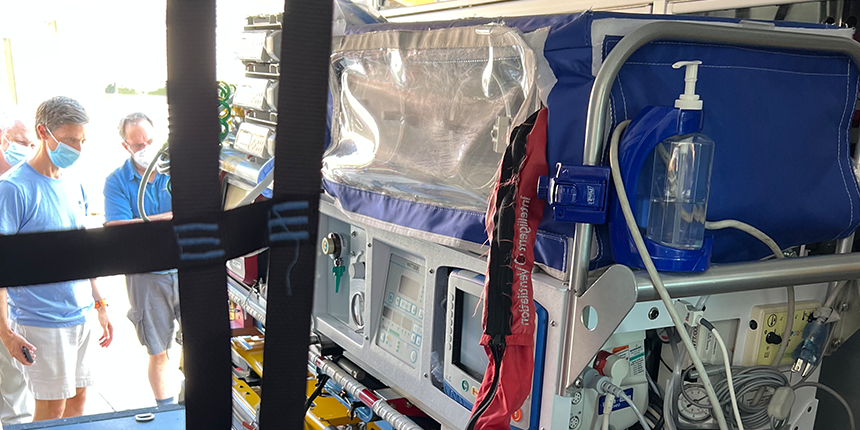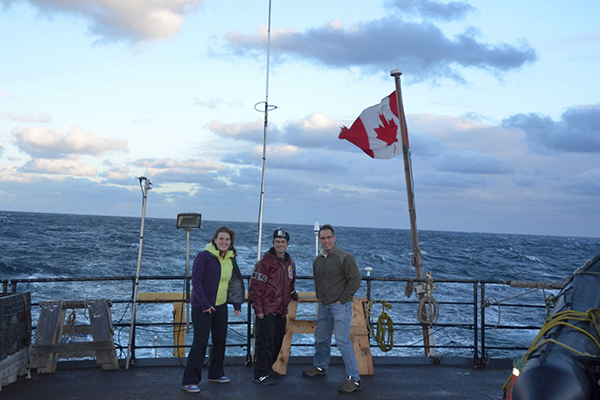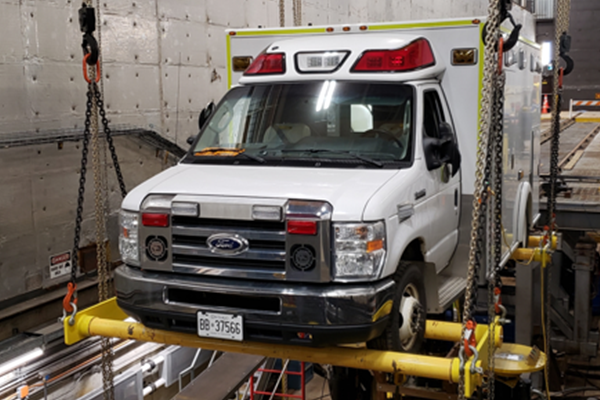
Rob Langlois specializes in safety critical systems and has joined his community in making transport safer for fragile newborns.

Most of us have become accustomed to the bumps, jostles, and loud noises of traveling down city streets and highways. Or the vibrating roar of an airplane take-off and landing. But for a newborn less than a month old, in a medical crisis, these motions and noises can do a lot of damage. How do you increase safety for patients that are vulnerable to the basic forces in transportation that most people take for granted? This is the problem that a team of experts—engineers, doctors, nurses, and equipment manufacturers and operators among them—are trying to solve. Rob Langlois, P.Eng., is a mechanical engineer as well as a Professor and Associate Dean of the Faculty of Engineering and Design at Carleton University, and he is part of this team that is working on safety critical transportation dynamics for neonatal patients—babies under 4 weeks old and often with serious medical conditions.
In medical emergencies, infant patients are dependent on fast medical transport to take them to specialized units that can provide the advanced level of care they require. While speed is of the essence, the noise and vibration from transportation could have dire consequences; infants are susceptible to vibration and noise in a way that most patients are not. The problem is complex, with multiple moving pieces involved. One of those pieces is the dynamics of the transport, something that Langlois has a lot of experience in.
Safety critical systems
Engineering was always going to be one of Langlois’ passions. As a child, he spent hours taking things apart and figuring out how they worked. As he grew older, Langlois was drawn to dynamics, “the relationship between forces and motion.”

His practical application of dynamics combined several transport components. “My first job had to do with safely landing, securing, and maneuvering helicopters on ship decks, which was a dream job for somebody who's interested in applied dynamics and computer simulation. That job involved aspects of ground, vehicle, and aircraft dynamics, ship motion analysis, aerospace design, and so on,” Langlois explains.
He enjoyed the complexity of the challenge; it involved multiple moving parts, dynamic modelling, developing computer simulations, and spending time investigating and understanding securing, safety, and design requirements, all while dealing with practical issues in the field.
“I've ended up in this sort of niche of safety critical dynamic systems. So, the neonatal patient transport project fits right in there,” Langlois said. Neonatal patients may need to be transported by ground ambulance, by air in medical transport airplanes and helicopters, or a combination of these. Reducing noise and vibration requires securing multiple components in different transport vehicles, while ensuring the safety of the patient and members of the medical transport team.
Bringing together the team
“I have to give credit to James Green,” Langlois emphasizes, his colleague who is also a professor of engineering at Carleton. Langlois credits Green for contacting him to join the project when it first began as a smaller study looking at vibration in inter-hospital transportation. The project, however, has grown quite a bit since its inception.
The neonatal project involves a large variety of people and organizations, including the Clinical Engineering and Neonatal Patient Transport teams from the Children’s Hospital of Eastern Ontario (CHEO), the Automotive and Surface Transportation and Flight Research Labs from National Research Council Canada, the Ottawa Paramedic Service, Ontario’s air ambulance service (Ornge), medical transport equipment manufacturers (International Biomedical and Stryker), Ontario’s Maternal Health Committee, and a team of researchers from two engineering departments at Carleton including many undergraduate and graduate students.
“This often happens in engineering,” Langlois explained. “You know you need involvement from different people with different expertise. Everybody's bringing their own specific skill set and resources together to solve the problem.”
The teamwork from various groups has been essential to properly investigate the interdisciplinary nature of the problem. “The best way to solve a problem is to dedicate time to fully understanding the problem as well as you can,” Langlois said.
The project’s scale, however, does lend itself to some specific types of challenges. Logistically, coordinating and collecting data from different sources was a challenge on its own. The use of equipment also had to be coordinated, and the interdependencies within the project meant that a delay in one part of the project inevitably affected others.
Despite the challenges, Langlois is pleased with the collaboration and enthusiasm of all parties involved. “One of the things that makes this project special is that it really fits into serving the public good… This is the one where everybody just wants to help because they share in the ultimate goal of the project. Everybody is motivated by the problem, everybody wants to help protect these vulnerable infants.”
Understanding the problem
Within this large, interdependent collaboration, what is it that Langlois is working on specifically? His team’s contribution to this project involves three pillars of investigation: characterizing the noise and vibration environment; developing laboratory tests capable of recreating conditions seen in the field; and developing solutions or mitigations to problems that were discovered.

For the experimental pillar, the problem also had to be examined on three scales, with the smallest being the isolette (the environmentally-controlled chamber the baby is transported in), as well as the combined transport and medical equipment that is on the stretcher with the isolette, and finally the entire vehicle (ambulance or helicopter) with all components combined.
“Along the way we've learned some very interesting things,” Langlois said. The project is ongoing, but already Langlois and his colleagues have six potential mitigation recommendations for neonatal transport units to explore. Some mitigations involve changing components of the existing system, such as upgrading vehicle suspensions or changing the mattresses used in the isolette. Other suggestions require specific engineering, such as reducing the amount of flexibility in the transport unit components so that the weight of the equipment, approximately 200 kilograms, is transferred more effectively to the structure of the vehicle, and testing and implementing vibration isolation measures to limit vibration from reaching the baby. The road conditions are also being considered, by looking at route planning, so that the fastest yet least bumpy roads can be taken by the driver, as well as real-time operator feedback that lets the driver know what the conditions are like for the patient in the back.
The project is not yet complete, but the team is learning more all the time and are excited to see what else they may discover in pursuit of safer, quieter neonatal transportation.
Collaborating for the public good
Langlois has worked both in industry and in academia and has praise for both environments. “All engineers develop a common approach to problems, a common vocabulary, and a common understanding about processes and priorities,” Langlois said. No matter where he works or the projects he tackles, the increased collaboration between engineers from different disciplinary fields or different locations has created opportunities to work on larger, more complex projects.
Another inspiring change is the increased emphasis in engineering education on professional skills and the important role of engineers in society. “Engineers are being trained in a way that allows them to be much more involved in the whole progression of a project and in advocacy,” Langlois said. “The social conscience that engineers are trained to have will play an increasingly important role in industry,” he predicts.
Langlois believes that just as engineers are focused on serving the public good, so too are the other professionals he has worked with. He sees this in the ongoing neonatal project: the interdisciplinary collaboration will have a net outcome of improving the safety of some of the most vulnerable members of our community. “As far as engineering goes,” Langlois said, “the end goal is to do something that improves a process or a system or an object, right? Something that makes it better for people. Engineering is really all about contributing to improving and building better tomorrows.”
Engineers build more than just bridges. Building Tomorrows is a series that highlights the important contributions of engineers and the many ways they help to make our world a better place.


